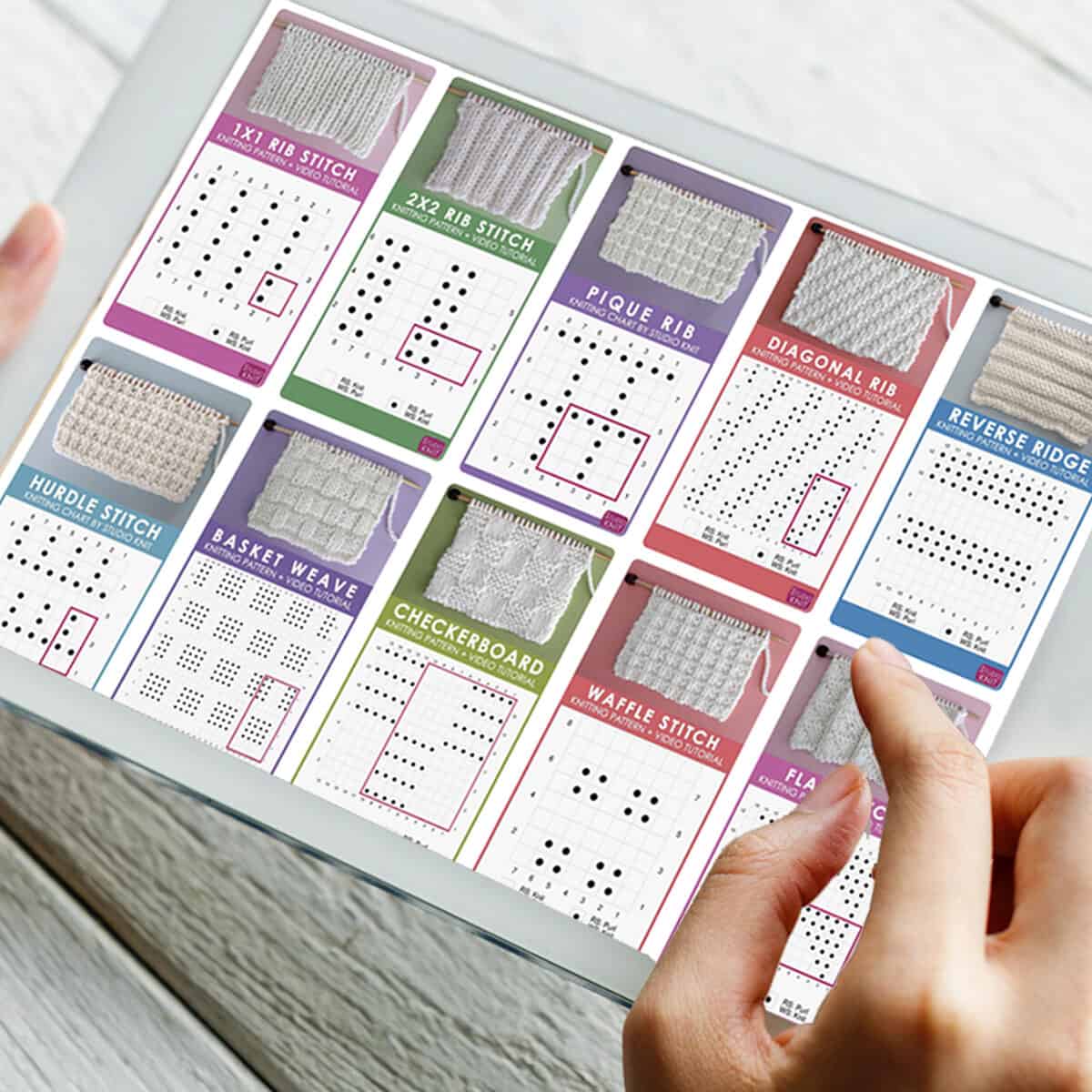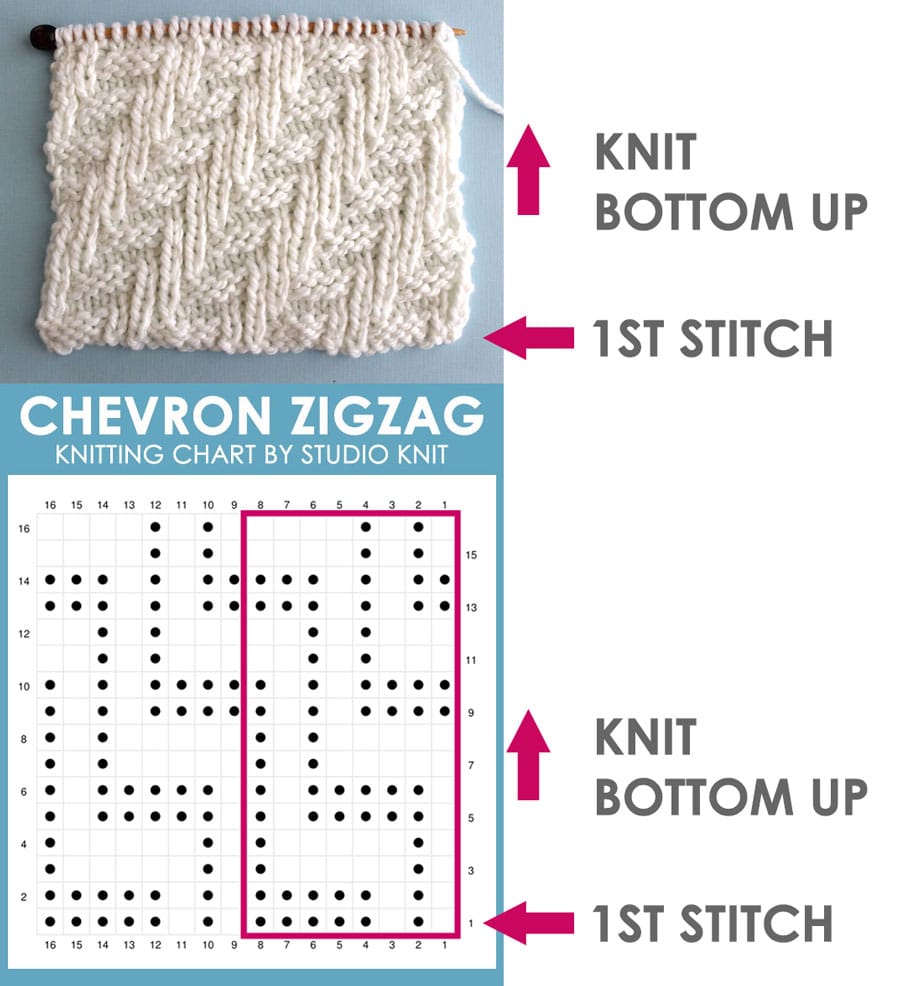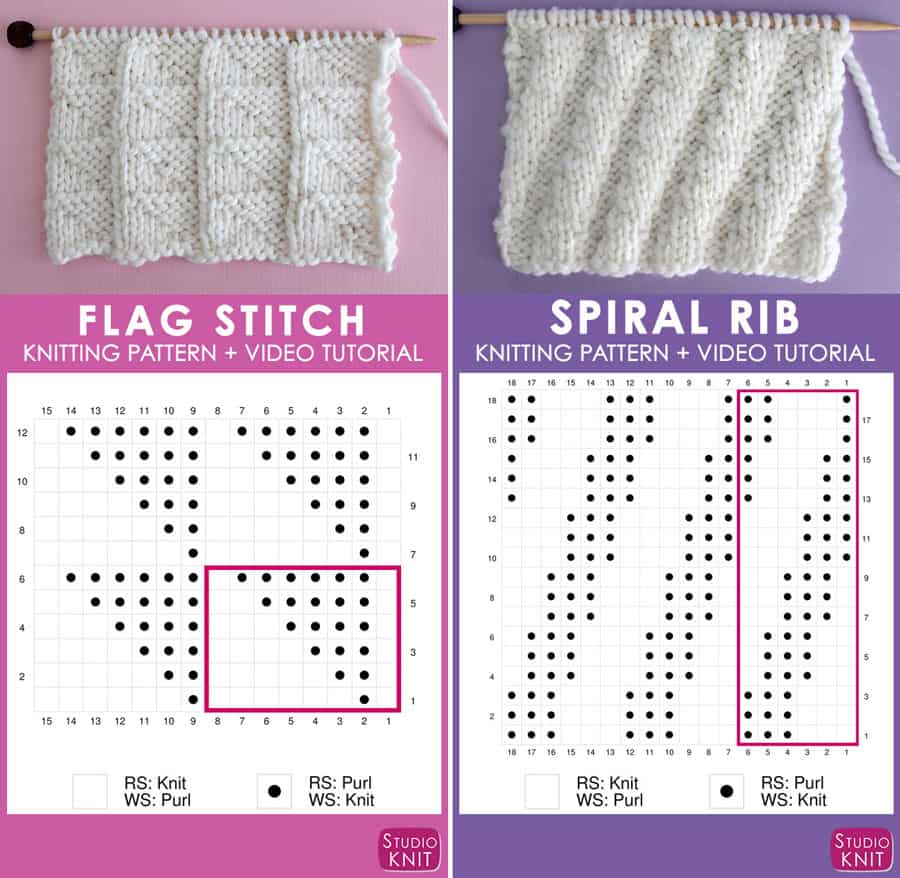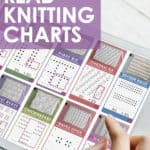How to Read a Knitting Chart for Absolute Beginners
Learning to read a knitting chart can feel challenging, but with a few basics, you’ll be reading charts and knitting confidently. This guide covers what you need to know, including how to read chart directions, identify symbols, and understand pattern repeats.

Table of Contents
What is a Knitting Chart?
A knitting chart is a visual tool that shows your pattern stitch-by-stitch. Most patterns come with both written instructions and a chart. For this guide, we’ll focus on charts with knit and purl stitches that are worked flat on straight needles.
In a chart, each square on the grid represents one stitch, showing you exactly what to knit as you go. This makes it easier to follow the pattern and visualize your project.

Understanding Right Side and Wrong Side
In a basic chart, the first row at the bottom right represents the right (front) side of your work. When you knit the first row, you’re working on the right side. Then, on row two, you’ll be on the wrong (back) side, where you’ll read the chart from left to right.
For this guide, I’ll show you how to read charts for knit stitch patterns using knit and purl stitches, worked flat on straight needles. My basic beginner patterns include both written instructions and a chart. You can find them on my website or in my Knit Stitch Pattern Book.
Once you understand the structure of a knitting pattern, you’ll be ready to tackle more complex patterns and textures, like lace eyelets and cable knits. Let’s start with the basics!
Watch Video Tutorial
Which Direction do you Read a Knitting Chart?
This lesson focuses on reading charts for flat knitting. After casting stitches onto your needle, the first stitch is on the right side of your row. So, you’re starting from the bottom of your work and knitting upward.

When you read a knitting chart, you start at the bottom right corner. It may seem unusual at first, but here’s why it makes sense:
Each square on the knitting chart represents a stitch. The first stitch at the bottom right of your knitted piece matches the bottom right corner of the chart, so you’ll knit from right to left.
After finishing the first row, turn your work to the wrong side for row two. Now, read the chart from left to right. Continue knitting by reading the odd-numbered rows (right side) from right to left and the even-numbered rows (wrong side) from left to right.

Knit Stitch Pattern Book
Love easy knitting? Get 50 more stitch patterns from my Knit Stitch Pattern Book available in both print and digital formats.
Is the First Row of Knitting on the Right Side?
In this example, the first stitch in the chart is at the bottom right, and we’re knitting from the bottom up. When you look at the swatch of this Checkerboard Pattern, you’ll see that it matches the direction of the chart, starting from the right and going up.
We knit the first row and all odd-numbered rows on the right side of the work. The second and all even-numbered rows are knitted on the wrong side.

Understanding Right Side and Wrong Side
In a basic chart, the first row at the bottom right represents the right (front) side of your work. When you knit the first row, you’re working on the right side. Then, on row two, you’ll be on the wrong (back) side, where you’ll read the chart from left to right.
If you’re unfamiliar with these concepts, check out my helpful tutorial on the right and wrong sides of knitting.
What are the Numbers on the Sides of a Knitting Chart?
- Odd numbers (1, 3, 5, etc.) on the right side of the chart indicate the rows on the right side of your work.
- Even numbers (2, 4, 6, etc.) on the left side of the chart indicate the rows on the wrong side.
- Numbers at the top or bottom of the chart help you keep track of the stitch count.
Chart Symbols for Knitting Stitches
Each square on the chart has a symbol that tells you what stitch to knit. In beginner patterns, the chart usually includes symbols for knit and purl stitches:
- Knit Stitch Symbol: Often a blank square or specific mark.
- Purl Stitch Symbol: Sometimes shown as a different color or symbol, like a dot.
The Legend Key next to the chart explains each symbol. Reviewing this key will help you understand which symbols are in your chart before starting.

Stitch Symbol Example
Each box in your knitting chart grid has a stitch symbol inside it. These symbols help you know when to knit or purl each stitch on your needle.
Legend Key for Knitting Charts
The Legend Key next to the chart explains each symbol. Reviewing this key will help you understand which symbols are in your chart before starting. It gives you a quick idea of the pattern’s difficulty.
If the Legend Key only includes knit and purl stitches, it’s a beginner-level project, and you can go for it. But if it includes unfamiliar techniques, you can decide whether to learn them first or skip the pattern if it seems too complex.
Legend Example
Here’s an example of a more complex pattern from my Heart Cables design. The Legend Key shows various stitch techniques. Depending on how familiar you are with these techniques, you can quickly decide if you want to knit this pattern. If it looks too challenging, you’ll know to pass on it.

Understanding Knitting Chart Repeats
A knitting chart often has highlighted sections called repeats. These repeats show parts of the pattern that you’ll knit multiple times. For example, a pattern might have an 8-stitch repeat that continues across each row. Repeats are marked with lines or boxes, making it easy to see which parts of the pattern repeat.
In these knit stitch patterns, the repeat portion is outlined with a highlighting box. For example, the Flag Stitch pattern has an 8-row repeat of 8 stitches. The Spiral Rib pattern has an 18-row repeat of 6 stitches. You can see these repeats at a glance.

Knit Stitch Symbol Switching
This is a good time to check the Legend Key again. Often, symbols for knit and purl stitches change depending on whether you’re on the right or wrong side of your work.

For example, a Knit Stitch might appear as a blank white box on the odd-numbered right sides (RS) of your work. On even-numbered wrong sides (WS), the symbol might switch to a black dot for a Knit Stitch.
At first, this might seem confusing, but it helps you see the textured pattern of your entire chart more clearly.
Build Your Confidence
Learning to read knitting charts is a powerful step toward expanding your skills. As you get comfortable with charts, you’ll find yourself ready to explore a wider range of patterns, textures, and techniques. With each project, you’ll gain confidence, opening up exciting possibilities for advanced designs. Embrace chart reading as part of your knitting journey—it’s a skill that will support and inspire your growth as a knitter!

Kristen McDonnell
Author • Designer • Teacher
Kristen from StudioKnit LLC produces knitting video lessons and pattern designs from her vibrant production studio on Half Moon Bay’s California coast.
Kristen McDonnell is the author of the highly acclaimed book Knit Stitch: 50 Knit + Purl Patterns featuring vintage and unique designs.

